फूल गोभी फसल के 6 प्रमुख कीट तथा उनका प्रबंधन
Cauliflower (Brassica oleracea L. var. botrytis) is an important winter vegetable grown in India. Bihar, Uttar Pradesh, West Bengal, Orissa, Assam, Haryana, Rajasthan and Maharastra are major cauliflower growing states. It also cultivated in non traditional areas of Tamil Nadu, Andhra Pradesh and Kerala. It is consumed as vegetable in curries, soups and pickles and low in fat and rich source of dietary fibers. In India, the major constraints for production loss are due to physiological disorders, pests and diseases. Insect pests are prime important as it cause serious economic damage cauliflower crop. Among all, DBM and tobacco caterpillar are notorious and chemical insecticides are widely used by the farmers to control these pests. Sole relay on synthetic chemicals is not recommended while considering pesticide residues and other issues like insecticide resistance, resurgence and secondary pests out break. Keeping the facts in view, here we discussed some the integrated approaches for the sustainable pest management programme and it would be highly useful for cauliflower growers across the country.
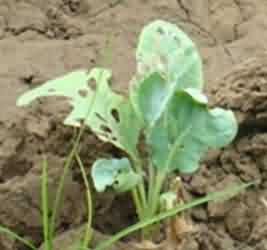 1. Diamond Back Moth, Plutella xylostella
1. Diamond Back Moth, Plutella xylostella
It is one of the serious pests of cauliflower in India and worldwide. The grayish brown moth having a typical whit patches, which form diamond like appearance in the wings while in rest. The eggs are laid singly on under surface of leaves veins. The larva is greenish with hairs on the body and it pupates by making a silken web.
Symptoms and damage
The larva is small and green in colour. It feed on leaves and makes bite holes, causes excessive defoliation, mostly on the growing part i.e primordial. Severe attacks could abort head formation. It may cause yield up to 80 to 90 per cent especially hot periods.
Management
- Planting Indian mustard as trap crop. Sowing of two rows of bold seeded mustard for every 25 rows of cauliflower in twice per season i.e 12 days preceding planting and 40 days later of first planting
- Application of 4 % Neem Seed Kernel Extract at head initiation stage i.e 17 to 28 days after planting
- Repeat of spray of NSKE 4% at 10 to 15 days interval, when the population buildup is high and avoid the spray after curd formation because it could affect curd quality.
- Spray of contact insecticides like quinalphos or chlorpyriphos 0.05%
- Bt formulations also can be used
2. Leaf webber, Crocidolomia binotalis
Moth with brownish fore wing lay overlapping flat eggs in group on the leaves. The larva with red head and body will have the longitudinal strips with short hairs and the pupation takes place in the soil with earthen cocoons.
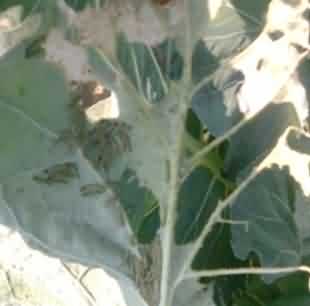 Symptoms and damage
Symptoms and damage
Group of hairy larvae damage the leaves. The leaves are skeletonized and larvae remain on the under surface of the leaves in webs. They also damage the heads and in severe case it leads to rotting.
Management
The same management measures recommended for DBM would be followed against this pest also
3. Stem borer or Hellula undalis of cauliflower
Larva looks brownish with black head and four longitudinal strips on the body. Moth appears with wavy lines and central elliptical markings on the fore wings. The pupation takes place inside the burrow of the stem as well in the soil.
Symptoms and damage
Larvae web the leaves and bore into main stem immediately after transplanting and prevent head formation, which results in production of multiple heads. Larvae also feeds on stalk or leaf veins and in severe attack it makes the produce to unfit for marketing.
Management
- Sowing of mustard 50-60 plant per meter and it needs thick foliage of mustard to reduce the infestation
- Other measures are as like against leaf webber and DBM
4. Tobacco caterpillar or Spodoptera litura in cauliflower
Grey colour moth having the forewings with white strip lines. Larvae are dark brown in colour and gregarious nature.
Symptoms and damage
Eggs are laid in clusters on under surface of leaves. Young larvae feed gregariously and skeletonize the leaves. Large larvae bore into heads. The infestation starts in the nursery itself so one should need to take preventive measures while preparing the nursery beds to avoid the main field infestation.
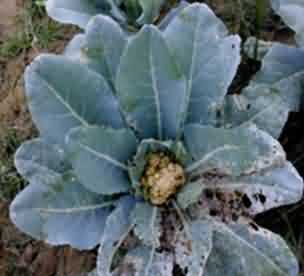
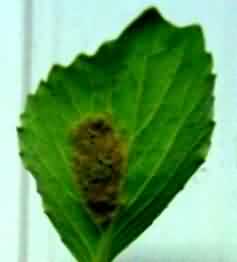
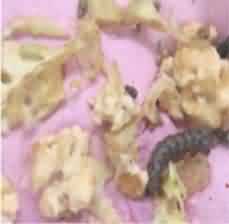
Management
- Treat the nursery soil with neem cake at 1.0 kg/m2
- Soil solarisation with use of white polythene
- Funnel trap baited with pheromone for S. litura @ 12/ha
- Collection and destruction of egg masses and gregariously feeding early instar larvae
- Need based application of SlNPV
- Spray of NSKE 4 % in early stage of larvae
- Collection and destruction of large larvae and use of sharp iron needle to kill the hidden larvae in the curd.
5. Aphids, Brevicornea brassicae, and Lipaphis erisimi
They suck the plant sap from the under surface of the leaves and infested leaves shows whitey mealy covering. Severe cases it affects quality of curd.
Management
- Planting mustard as trap crop
- Use of NSKE 4% when control is necessary
- Application of Oxydemeton methyl 0.02%
6. Painted bug of cauliflower
Bugs are small, black in colour with red and yellow lines. It lays barrel shaped brown eggs.
Symptoms and damage
Both adults and nymphs suck sap from the leaves, shoots and affect the vigour of the plant, results leaf withers.
Management
Single or spot application of dimethoate and oxydemeton methyl 0.05% would be effective
References:
- Elements of economic entomology by B. Vasanthraj david
- Integrated Pest Management in Early Cauliflower by Singh et al 2002
- Hand book of Horticulture by ICAR
- www.ncpahindia.com
Author
V. Karuppaiah,
Ph.D Scholar,
Division of Entomology, IARI, New Delhi-110012
Email:
